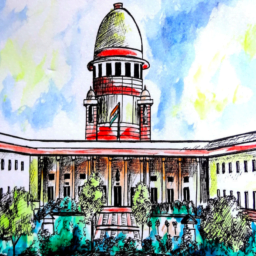INTRODUCTION
The right to live on this planet is not only exclusive to human beings but to every being on this planet however frequently we become inhumane toward their agony, simply because creatures can’t communicate in the language of people, they don’t have a voice. We are human since we show some care and psyche of our own and, over that, we have a voice to articulate our thoughts. Be that as it may, in showing pitilessness to these quiet creatures we lose all our mankind.
Torture or cruelty to creatures has become a global issue concerning government assistance. Creatures are exposed to cruel practices because of numerous human requirements. This is a significant issue that should be tended to and halted. Brutality towards creatures has prompted numerous passings, and it is slowly expanding as the total populace is expanding.
It’s not been that long since a viral video was posted on the popular video-sharing website, YouTube, where hydrogen balloons were tied to a dog’s back in an attempt to make him fly. In another case, a dog was beaten up by three minors[1]. There are numerous cases of animal cruelty. But in most cases, these offenders get away with minimum punishment. Many wildlife activists and animal rights organisations[2] have asked time and time again for more stringent punishment.
The Prevention of Cruelty to Animals Act, 1960 enacted by the parliament in 1960[3], the act seeks to prevent all this torture or cruelty which is done in any animal.
NEED OF ANIMAL LAWS
Flora and fauna is a gift that is given by Mother Nature that many underestimate. The term untamed life doesn’t just cover wild creatures, but additionally also includes every undomesticated animal, including birds, bugs, plants, even infinitesimal life forms. To keep a sound environmental equilibrium on this planet, all living animals ought to be treated as significant as people.
Every creature plays its part in making a balanced ecosystem. Just like a castle of cards, every single creature has its importance and if any one of these creatures is disturbed the whole castle of this ecosystem collapses. As we are at the top of the food chain or this castle of cards, we must protect and save wildlife. Without the base, the top of the castle can not stand on its own. Laws are important for the same. To make sure that the right of every animal to live on this planet without torture or suffering. Just like laws help alleviate the pain and misery of humans, in the same way, laws must be there to alleviate any sort of pain or suffering which may be caused due to torture or cruelty. All laws of consideration prevent creature brutality. In the case of domesticated animals, nothing can legitimize pitilessness, as animals can do little to secure themselves. Numerous kinds of cruelty are done to domesticated animals. It is endured basically by those who have little information on how the delicate balance of nature is to be kept up with and by various species.
NEED OF PREVENTION OF CRUELTY TO ANIMALS ACT
The need of this act is to protect any unnecessary pain which may be inflicted by any human being in the lives of voiceless creatures or animals, as defined by the act in Section 2(a), any creature besides human being, and to prevent animals from cruelty. Indian penal code in sections 428 and 429 does talk about punishment but that’s only in certain cases when an animal is maimed, poisoned or is injured. Whereas, the prevention of cruelty to animal acts has more broad horizon.
NEED OF AMENDMENT
The law has been severely outdated. As per section 11 of the act, first-time offenders will be liable for a fine not less than ₹10 and may extend up to ₹50. This fine is so low that the offender can pay it with a tip. The same goes for the offence committed for the second time. The fine for an offence committed for the second time is ₹25 which may extend to ₹100 or 3 months jail or both.
Another thing that the act lacks which was pointed out by The Federation of Indian Animal Protection Organisations[4], is the provision of gruesome cruelty and the punishments of such act. Since the offenders get away with punishments which are given in section 11, despite the nature of the offence is a gruesome one.
CURRENT STATUS
The government has recently made a draft amendment[5] for more stringent punishments in the prevention of cruelty to animals. Like in the case of death of an animal due to cruelty or torture the punishment will be ₹75000 or jail time for five years. In the draft, the punishment is divided into three kinds minor, major (causing disability permanent in nature) or a cruel act causing the death of an animal and the punishments are decided accordingly for all three.
In April of this year, a webinar was done by the agriculture ministry regarding the amendments of The Prevention of Cruelty to Animals Act, 1960. Many suggestions were also given by various stakeholders regarding the amendment including making punishments cognizable.
CONCLUSION
Article 48A[6] of the Indian constitution says that the state shall take steps to protect the flora and fauna of the country, it might not be legally enforceable but it should be kept in mind when these laws are framed. There are also fundamental duties for the citizens to protect the flora and fauna, namely Article 51 A (g)[7] of the constitution of India. The right to life of an animal is also stated in the case of Animal Welfare Board of India v. A. Nagaraja and Ors.[8]
Hence, every animal must be protected from any sort of cruelty and to make that possible stringent rules are important to work on the current status of barbarous treatment to creatures. Individuals need to team up with government assistance bodies and report when an offence happens. Creatures are worthy of empathetic treatment as well and ought to be considered as living creatures and respected with poise. The Act ought to be altered occasionally and the fines and punishments ought to be made more severe.
Author(s) Name: Prajanay Vyas (Student, Himanchal Pradesh National Law University, Shimla)
References:
[1] Akshita Saxena, ‘Based On Judge’s Letter, Kerala High Court Takes Suo Moto PIL To Control Animal Cruelty’ Live Law (1 July 2021) < Based On Judge’s Letter, Kerala High Court Takes Suo Moto PIL To Control Animal Cruelty (livelaw.in)> accessed 8 July 2021
[2] TNN, ‘Proposed amendments to the Prevention of Cruelty to Animals Act: FIAPO seeks stricter penalties’ Times of India (May 11, 2021) < Proposed amendments to the Prevention of Cruelty to Animals Act: FIAPO seeks stricter penalties | India News – Times of India (indiatimes.com) > accessed 8 July 2021
[3] The Prevention of Cruelty to Animals Act, 1960 <India Code: Prevention of Cruelty to Animals Act, 1960> accessed 8 July 2021
[4] TNN (n 2)
[5] Vishwa Mohan, ‘Cruelty to animals may soon attract Rs 75,000 fine, 5-year jail’ Times of India (6 Feb. 2021) <Cruelty to animals may soon attract Rs 75,000 fine, 5-year jail | India News – Times of India (indiatimes.com)> accessed 9 July 2021
[6] The Constitution of India, 1950 Art. 48A
[7] The Constitution of India, 1950 Art, 51A (g)
[8] Animal Welfare Board of India v A. Nagaraja and Ors. [2014] (7) SCC 547
















